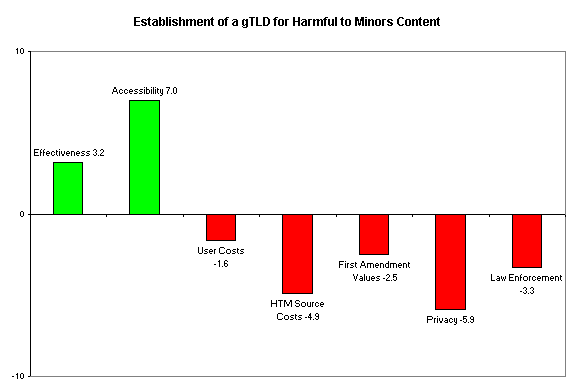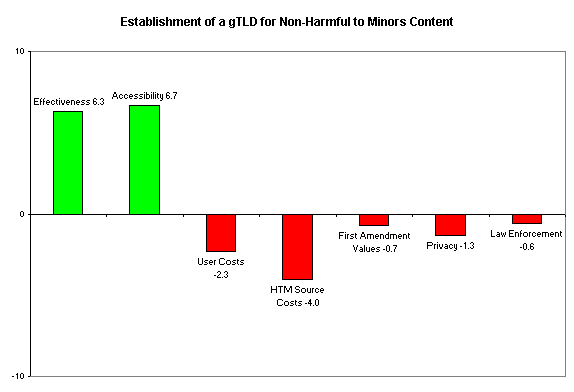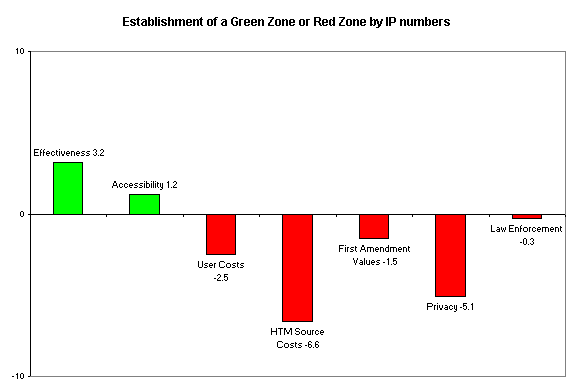|
E. New Top-Level Domain/Zoning
10. Establishment of a gTLD for harmful to minors content
Creation for voluntary use of a new top level domain (e.g., .xxx or .adult) the use of which would be understood to signify that materials on web pages located in such domain (and email coming from such domain) are harmful to minors materials -- and the existence of which would make it easy for browsers or ISPs to filter out all material so located.

Commentary
- This method is technically feasible but such a domain does not currently exist. It requires that ICANN establish such a new top-level domain.
- This system may be only moderately effective because of questions about whether harmful to minors content sources would locate material exclusively in the .xxx domain. This method also may be inapplicable to chat, email, newsgroups and instant messaging. Use of the domain name system to implement policy raises concerns.
- Privacy and First Amendment concerns may be raised by the clear identification of a "red light district" and the stigma involved in being found there, and the concern about a "slippery slope" toward mandatory location in the gTLD.
- This approach raises the possibility of adverse effects on law enforcement, because creation of a "red light district" might serve as an attractive nuisance, and because incentives for law enforcement to prosecute unlawful material in the red light district might be reduced.
11. Establishment of a gTLD for non-harmful to minors content
Creation for voluntary use of a new top level domain (e.g., .kids) the use of which would be understood to signify that materials on web pages located in such domain (and email coming from such domain) would universally be considered suitable for minors of all ages -- and the existence of which would make it easy for browsers or ISPs to establish "green zone" features that point or accept only to such materials.

Commentary
- This method is technologically feasible but such a domain does not currently exist. It requires that ICANN establish such a new top level domain. Again, the use of the domain system to implement policy raises questions. Alternatively, a lower level domain (such as .us.kids) could be established without the need for ICANN to take action.
- This approach could be an accessible and generally effective way to protect children from harmful to minors content. It would be more effective to the extent that children were restricted to such a zone. It would be more visible than mere establishment of multiple greenspaces or lists of child-appropriate sites. It would not, however, be effective at addressing content located in chat, newsgroups, or instant messaging.
- Costs to consumers and other end-users, to sources of harmful to minors content, to law enforcement, and to privacy interests are low.
- First Amendment concerns arise from fears that children, particularly older teens who are restricted to this zone, may be unable to access potentially informative and appropriate material.
- Creation of such a gTLD could have an adverse effect on law enforcement because of the risk that concentration of children's activities in this area could attract predators.
12. Establishment of a "green zone" or "red light zone" by means of allocation of a new set of IP numbers
Creation for voluntary use of a set of IP numbers (in the new IP version 6 protocol, which has not yet been widely implemented) the use of which would be understood to signify that materials on web pages on servers with such IP numbers (or email coming from such servers) would be either non-harmful to minors material or harmful to minors material, respectively. Any material not in such an IP number zone would be considered to be in a "gray zone" and not necessarily either harmful to minors or non-harmful to minors.

Commentary
- This is a proposal for a system that does not currently exist. Technical difficulties involved in implementing this technology make effectiveness uncertain. Effectiveness would require substantial effort to attach content to specific IP numbers. This approach could potentially reduce flexibility and impede optimal network performance. It would not be effective at blocking access to chat, newsgroups, or instant messaging.
- Creation of a voluntary system dividing IP numbers could be the first step toward a mandatory division of IP numbers, which raises significant First Amendment concerns.
- This approach would impose significant costs on content sources, because it would require publishers to redesign hardware and allocate content between appropriate IP numbers.
- This approach would have little adverse effect on privacy or law enforcement.
|



